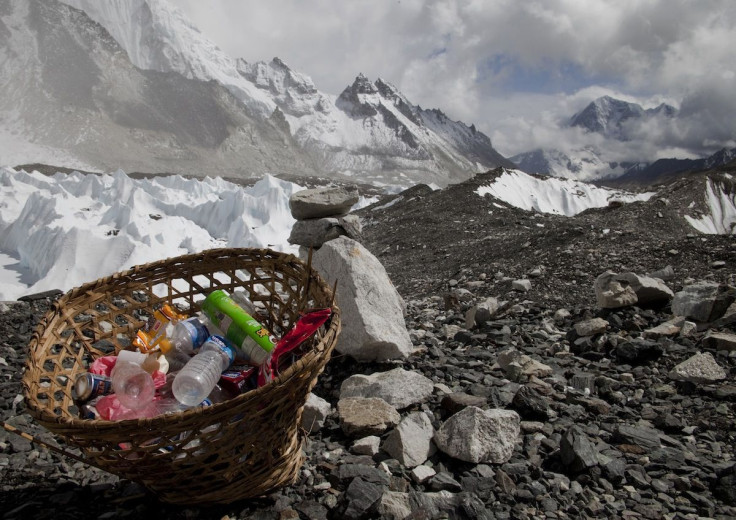Nepal Forces Mount Everest Climbers To Double As Trash Collectors

It’s a dirty secret of the world’s tallest mountain and one that hardly fits with its public perception, but after six decades of mountaineering, the Nepal government says Mount Everest has become riddled with an estimated 50 tons of rubbish. There are empty oxygen cylinders, tent debris, batteries and climbing gear -- not to mention human refuse and the bodies of fallen climbers, whose corpses don’t decompose in the permanently frozen highlands.
Nepal manages the more popular southern route to the peak and, though it already requires climbers to descend to base camp with all their own waste, the government said this week that its efforts had failed to leave the revered mountain pristine. As a result, it will force all mountaineers to double as trash collectors beginning April 1.
The government unveiled the policy Monday, asking climbers who scale Everest above 5,300 meters (17,388 feet) to bring back eight kilograms of rubbish (17.6 pounds) in addition to their own litter. At stake if they refuse is a $4,000 deposit that’s currently reimbursed only if climbers can prove that they’ve brought down their own gear and supplies.
“Our earlier efforts have not been very effective. This time, if climbers don’t bring back garbage, we will take legal action and penalize them,” Madhusudan Burlakoti, the Tourism Joint Secretary of the Nepalese Ministry of Culture, Tourism and Civil Aviation, told the Agence France-Presse news agency.
Expedition leaders have been accused of understating the amount of gear they packed so as to stave off any problems if they return with less than they claimed. Under the new policy, however, Everest expedition members will have to take their gear and their eight kilograms of trash for inspection at a new office to be set up next month at base camp.
Today’s mountaineers say much of the debris strewn about the Himalayan peak dates back to the early days of Everest exploration, when it was a common practice for climbers to unburden themselves of any gear they no longer needed. Rules and ethics of the sport have changed considerably since then.
Everest Camp 3 (7,400 meters; 24,278 feet) and Everest Camp 4 (8,000 meters; 26,247 feet) are said to be the dirtiest areas on the mountain, with hundreds of discarded oxygen tanks. Though cleaning expeditions regularly trawl the higher slopes, they’ve been unable to make a considerable dent in the dump piles.
Some, however, fear the stricter rules on trash collection will affect the Sherpa guides much more than the climbers. Sherpas often assist in the carrying of materials and play a vital role for Everest’s increasing number of inexperienced climbers.
Just last month Nepal lowered its individual fees for climbing the world’s highest peak from $25,000 to $11,000 and abolished group discounts that it said created excessively large expedition teams. Critics, however, fear that the lower fees will only entice more climbers to an increasing crowded mountain.
Tensions broiled over last year after three European climbers attempted to pass local guides who were setting up ropes for an expedition team. The ensuing “brawl” made headlines around the world and highlighted the seemingly bizarre issue of traffic jams at the top of the world.
The Nepal government said last month in an overhaul of its mountaineering policies that it would install government personnel, soldiers and police at base camp to resolve conflicts and aid in any problems. These officials will likely sit near a separate inspection office at base camp for those returning from their mission of clearing a path to the world’s tallest peak.
© Copyright IBTimes 2024. All rights reserved.












